
It would be Ukraine’s third large-scale counteroffensive since the war began in February last year, with analysts forecasting that it presents an entirely different battle to previous offensives in Kherson and Kharkiv.
Ukrainian officials in recent days have denied claims that the counteroffensive has begun. Russia’s defence minister Sergei Shoigu’s said on Tuesday troops had thwarted it by killing or wounding 3700 Ukraine soldiers.

A Ukrainian soldier fires a mortar at Russian positions on the frontline near Bakhmut.Credit: AP
Yevgeny Prigozhin, leader of the Russian Wagner militia fighting in Ukraine and often at odds with Moscow, dismissed the ministry’s claims of heavy Ukrainian losses as “wild and absurd science fiction”. Ukrainian officials called Moscow’s claims “delusional.”
“We’ve seen all the preliminary operations of the political and operational levels of long-range strikes into Russia, to distract and to play mind games with the Russians. We may well be seeing the very early parts of a larger offensive,” said retired Australian major-general Mick Ryan.
“But as we say in the army, first reports are always wrong. And I guess we’ll see over the coming hours and days.”
On Tuesday, both sides blamed each other for the destruction of a major Soviet-era dam, which was blown up, spilling millions of litres of water, forcing the evacuation of thousands and cutting off water supplies.
It was unclear how the dam explosion would impact Ukraine’s counteroffensive, however observers this week said it made a river crossing by Ukraine’s military from the direction of Kherson and Mykolaiv towards enemy territory unlikely.
Ukraine’s objective
Reclaiming its territory and restoring authority within its internationally recognised borders are at the heart of the counteroffensive. And that means Crimea too, which Russia seized and annexed from Ukraine in violation of international law in 2014.
Loading
Tim Willasey-Wilsey, visiting professor of King’s College London, said Ukraine could not rely on the element of surprise it had previously because “everyone knows they’ve got to do a counteroffensive, and everyone knows they don’t have a lot of time to do it”.
Many military observers expect Ukraine to try to break Russian defences toward the Sea of Azov coast to reclaim the land corridor to Crimea that Moscow created after capturing the key port of Mariupol in May 2022.
Ryan says Ukraine will also be aiming to destroy the Russian military’s capacity to undertake any more offensives this year across the front.
“They also want to ensure that countries outside of Ukraine see this as a successful offensive,” he said.
“It’s very difficult to get right, but they’ve done everything they can to put themselves in the box seat to success.”
How has Ukraine timed the action?
The timing has been influenced by a complex web of factors; from the political objectives of President Volodomyr Zelensky to the needs of the West to see progress.
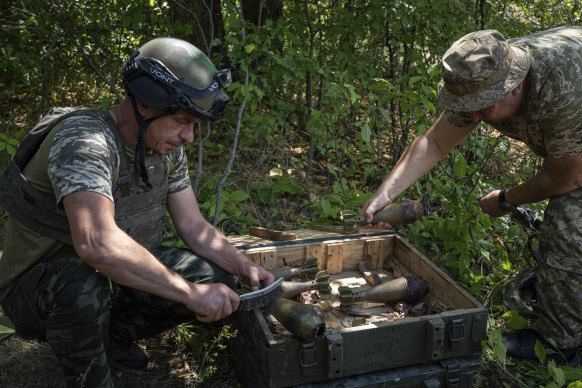
Ukrainian soldiers clean mortar shells during training in the Kharkiv region.Credit: AP
Looming over Russia is pressure for success, lest Western governments feel emboldened to scale back aid or compel Ukraine to go to the negotiating table with Russia, says ANU military expert Charles Miller.
Time has also been critical in the psychological operations and logistic preparations needed to ready Ukraine’s nine Western-trained brigades, while providing them with new equipment.
Willasey-Wilsey said ensuring the arrival of the superior Leopard tanks, as well as the return of troops being trained in NATO countries has also been key to the timing.
Loading
And there was the question of the ground drying out, “because you don’t want to get tanks bogged down” during an advance, he said.
Analysts say Ukraine’s recent strategy of launching multiple attacks, or “shaping operations” on different sectors of the frontline is designed to distract Russia and force it to disperse its resources.
”The attacks in the Zaporizhzhia and the Donetsk regions, the developments in Russia’s Belgorod region …are all part of preparations to the Ukrainian counteroffensive,” said Ukrainian military analyst Roman Svitan.
Reconnaissance missions to identify Russia’s strengths and weaknesses have been critical for Ukraine to successfully launch the preliminary long-range strikes that weaken Russia’s logistics, headquarters and reserves.
Ukraine is better equipped than Russia
Ukraine’s military arsenal, most of which has been supplied by the US, dwarfs that of Russia.
From the German Leopard 2 tanks, which are considered more fuel-efficient than most other Western tanks, to the deadly Himars long-range missiles.
“It’s got some good kit, better kit than the Russians,” says Willasey-Wilsey.
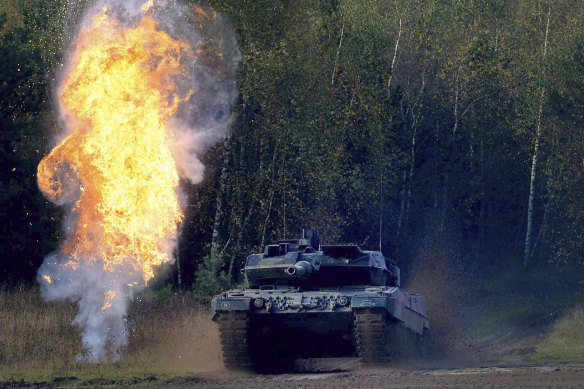
A Leopard tank in a “Land Operations” information training exercise in Bergen, Germany.Credit: dpa/AP
“The intelligence is far, far better than anything the Russians have got. And they’ve got massive motivation.”
Meanwhile, Australia is expected to answer Ukraine’s pleas for the missile-capable, four-wheel-drive armoured “Hawkei” as part of a forthcoming support package.
Northwestern University Professor William Reno, who studies foreign military training, said the backing of the nation could not be forgotten.
“Ukrainians generally fight in areas where they have popular support, while Russian soldiers discover that local people regard them as invaders … Ukrainians benefit from home field advantage.”
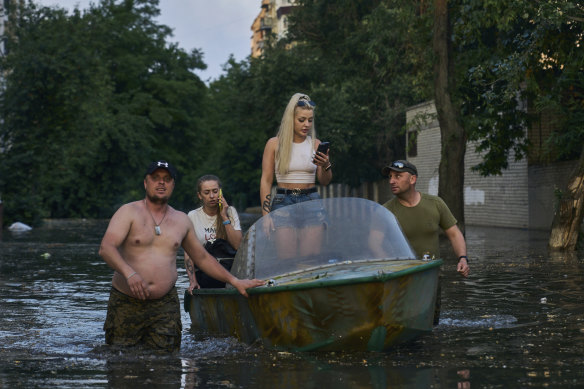
Boats carrying residents being evacuated from a flooded neighbourhood in Kherson, Ukraine, following the desrtruction of a major dam.Credit: AP
Russia’s current targets
After rolling failed offensives, the loss of tens of thousands of troops, depleting resources and plummeting morale, Ryan predicts Russia’s current objective will be “holding on for grim death”.
“They may have built lots of obstacles, but the troops who are defending them are not first class. And we have to question the will to hold on to the territory, given the poor training and leadership the Russians have demonstrated so far.”
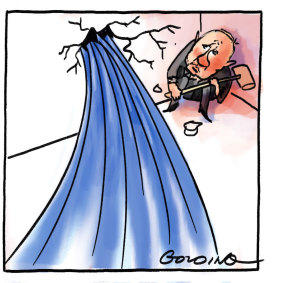
“Holding on for grim death.”Credit: Illustration by Matt Golding
Military watchers say one of the most significant changes in the war, as the counteroffensive begins, will be Russia’s slide into a defensive role, to sit behind its fortifications.
It is yet another example of the shift in Russia’s military tactics; from first trying to take the whole of Ukraine, then just the east, and now simply trying to defend what it already has.
“They’re not trying to attack anymore,” Willasey-Wilsey argues. “The change in Kremlin tactics is quite notable: defend what we’ve got and call it a win.”
What happens if it fails?
Any counteroffensive is likely to be long and difficult, taking weeks, if not months, to play out.
If it fails, the political and military ramifications will be many, and that’s not accounting for the deaths of thousands more soldiers. A failure would mean Ukrainian citizens remain under occupation and there will most likely be greater pressure from nations, particularly China for negotiations, Ryan believes. However, the retired army general is optimistic.
“I don’t know whether that’s a high probability outcome. I think it’s actually a very, very low probability outcome given the preparations for this offensive.”
Willasey-Wilsey, who has argued that Zelensky has six months to win the war before the West is likely to pressure him to negotiate with Putin, has a less rosy outlook, and suggests the balance of advantage has swung slightly in favour of Russia.
“The Ukrainians have got to win, the Russians have only got not to lose.”
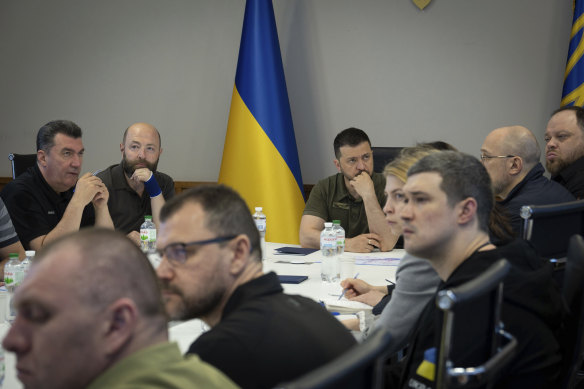
Ukrainian President Volodomyr Zelensky (centre) could face pressure from Western nations to win the war quickly.
He said a failed counteroffensive of the course of the coming months could lead to a “frozen conflict” that plays to Putin’s hand.
“He loves to go in and create these frozen conflicts which don’t resolve themselves. And it may be instantly that there isn’t a negotiated settlement … and we are just left with a festering sore that continues for years and years and years.“
Get a note directly from our foreign correspondents on what’s making headlines around the world. Sign up for the weekly What in the World newsletter here.



























